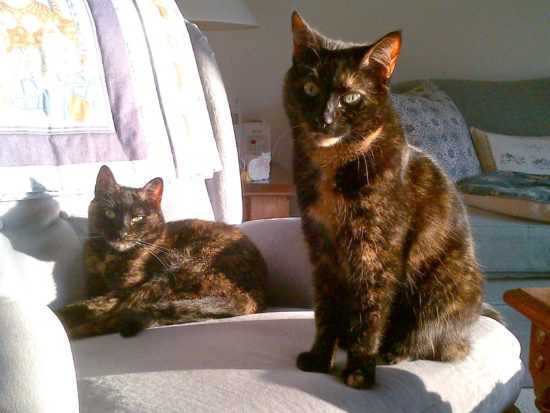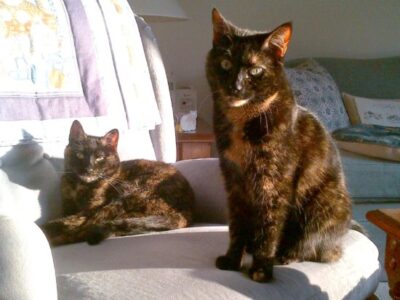
Tortoiseshell cats are beloved for their unique and stunning appearance as well as their distinctive personalities. Known for their beautiful coats of mixed colors—primarily shades of black, orange, and sometimes cream or gold—tortoiseshell cats, often referred to as “torties,” have a charm that goes beyond their appearance.

They possess intriguing traits that captivate the hearts of cat lovers worldwide. In this guide, we will explore the allure of tortoiseshell cats, their history, personality traits, care considerations.
Understanding Tortoiseshell Cats
Tortoiseshell cats are not a specific breed but rather a coat pattern, meaning any cat breed can have a tortoiseshell coloration. The pattern itself is a mix of dark and light colors, typically black and orange, with the occasional presence of a cream or gold hue. The colors are marbled or blended in a way that creates a “tortoiseshell” effect, hence the name.
Although tortoiseshell cats are commonly mistaken for a breed, the term actually refers to the unique color pattern, which results from a combination of genetics. Specifically, the genes responsible for the orange color are linked to the X chromosome.
Since females have two X chromosomes, they are more likely to exhibit the tortoiseshell coat, while males typically only have one X chromosome, making them far less likely to have this distinctive coloring.
Types of Tortoiseshell Cats
1. Classic Tortoiseshell (Tortie): This is the traditional tortoiseshell coat pattern, with a mix of black and orange fur in random patterns across the cat’s body. This color pattern can include a variety of shades, ranging from dark blacks to fiery oranges and pale creams.
2. Dilute Tortoiseshell: Diluted torties are lighter in color, featuring softer pastel hues, such as a mixture of gray (diluted black) and cream (diluted orange). This gives the cat a more muted, “softer” appearance compared to the classic tortoiseshell.
3. Tortoiseshell with White (Tortie & White): Some tortoiseshell cats have white patches in addition to their signature mix of black and orange. This creates a tri-color effect, often referred to as a “calico” pattern. These cats are typically known for their vivid personalities.
4. Tabby Tortoiseshell: In addition to the classic or diluted colors, some tortoiseshell cats also feature tabby striping. This gives their coat an additional layer of complexity, with subtle striped patterns adding texture to the marbled coloration.
The Fascination with Tortoiseshell Cats
Tortoiseshell cats are often regarded as unique not just because of their striking appearances but also because of their intriguing personalities.
There’s an old belief that torties are special because they possess certain traits due to the distinct genetic makeup that gives them their coat color. This theory, often referred to as the “tortitude” myth, suggests that tortoiseshell cats are often more feisty, independent, and strong-willed than other cats. While this isn’t a scientific fact, many tortie owners swear by the distinctive character of their pets.
What Makes Tortoiseshell Cats So Special?
A Beautiful Coat Pattern
Tortoiseshell cats are incredibly eye-catching. Their coats, made up of random swirls and patches of vibrant colors, make each tortie unique. The variety in their coats means that no two tortoiseshell cats are exactly alike, which only adds to their allure. Whether they are a deep, fiery mix of orange and black or a delicate pastel palette of gray and cream, tortoiseshell cats are visually stunning.
Playful and Energetic
Tortoiseshell cats tend to be playful and energetic. They enjoy interactive play and can often be found chasing toys or exploring new environments. This zest for life makes them entertaining companions and helps form a bond with their human family members.
Affectionate and Loyal
While they are known for being independent, many tortoiseshell cats also form strong bonds with their humans.They can be extremely affectionate and may follow their owners around the house, curl up in their laps, or purr contentedly when given attention. Despite their independent nature, many torties enjoy socializing and bonding with their families.
Feisty and Independent
One of the most commonly shared traits associated with tortoiseshell cats is their feisty attitude. Tortoiseshell cats are often described as having a “strong personality” or “tortitude.” They can be stubborn, opinionated, and unpredictable, which gives them a bit of an attitude.
While this can make them more challenging to train or handle, it also makes them endearing to those who appreciate their spirited nature.
Vocalization and Communication
Tortoiseshell cats are known to be quite vocal. They will often express their emotions through meows, purrs, and trills, making them communicative companions. Whether they are expressing their happiness, excitement, or desire for attention, torties are generally not shy about making their voices heard.
Social and Assertive
While some cats may be shy or reserved, tortoiseshell cats tend to be more social and assertive. They are not usually the type of cat to sit back and observe—they prefer to be involved in whatever is going on around them. Whether it’s following their humans from room to room or interacting with other pets, tortoiseshell cats tend to be active participants in the household.
READ ALSO: How Much Benadryl Should You Give Your Dog? A Quick Guide
Caring for Tortoiseshell Cats
Tortoiseshell cats, like all cats, require proper care and attention to ensure they live long, healthy, and happy lives. Their care requirements are fairly typical, but there are a few things to keep in mind to ensure they thrive.
Diet and Nutrition
As with all cats, a well-balanced diet is essential for a tortoiseshell cat’s health. Ensure that your tortie’s food is nutritionally complete, with appropriate amounts of protein, fat, and essential vitamins and minerals. Some tortoiseshell cats may be prone to obesity, so it’s important to monitor their food intake and provide regular exercise.
Grooming
Tortoiseshell cats typically have short to medium-length coats, which are relatively low-maintenance. However, brushing them regularly will help reduce shedding and prevent mats from forming in their fur. Cats with long coats may require more frequent grooming.
Regular Veterinary Care
Routine veterinary checkups are essential to maintain your tortoiseshell cat’s health. Like all cats, torties should be vaccinated and receive regular flea, tick, and worm treatments. Regular vet visits can also help identify any potential health issues early, allowing for timely intervention.
Enrichment and Play
Tortoiseshell cats are active and curious, so they require plenty of mental and physical stimulation. Provide them with toys, scratching posts, and interactive activities that engage their natural hunting instincts. Regular playtime will help prevent boredom and encourage healthy exercise.
Socialization
While tortoiseshell cats can be independent, they generally enjoy human interaction and socialization. Spend quality time with your cat daily, whether it’s petting, playing, or simply relaxing together. Tortoiseshell cats tend to form strong bonds with their human family members, and their loyalty is part of what makes them so special.
Common Myths About Tortoiseshell Cats
While tortoiseshell cats have a reputation for being independent or having a strong-willed personality, it’s important to remember that every cat is an individual. Not all tortoiseshell cats will fit the “tortitude” mold. Here are some myths and facts about torties:
Myth: All tortoiseshell cats are aggressive.
Fact: Tortoiseshell cats have a reputation for being feisty, but not all torties are aggressive. Their personalities vary, and some tortoiseshell cats are calm and loving.
Myth: Tortoiseshell cats are always female.
Fact: While most tortoiseshell cats are female due to the genetics involved in the color pattern, male tortoiseshell cats do exist. These male torties are quite rare and often have genetic abnormalities.
Myth: Tortoiseshell cats are always high-maintenance.
Fact: Tortoiseshell cats are often described as having “tortitude,” but this doesn’t mean they are more high-maintenance than other cats. They may require a bit more attention and patience due to their strong personalities, but with the right care, they can be wonderful companions.
FAQs
Are tortoiseshell cats good with children?
Tortoiseshell cats can be good with children, especially if they have been socialized from a young age. Their playful and curious nature can make them great companions for active families.
However, because torties can be a little more independent and feisty, it’s important to teach children how to handle them gently.
Do tortoiseshell cats get along with other pets?
Tortoiseshell cats are often social and assertive, so they may get along well with other pets, including dogs and other cats. However, their independent streak can sometimes make them territorial, so proper introductions and monitoring are recommended when bringing a new pet into the home.
Do tortoiseshell cats require special care?
Tortoiseshell cats don’t require significantly different care than other cats, but they can benefit from regular grooming and plenty of interactive play to keep them entertained. As with any cat, regular vet checkups and a balanced diet are essential to maintaining their health.
What is the life expectancy of a tortoiseshell cat?
The average lifespan of a tortoiseshell cat is similar to other domestic cats, typically ranging from 12 to 16 years, although some can live even longer with proper care.
Are tortoiseshell cats more prone to health issues?
Tortoiseshell cats do not have any specific health issues related to their coat color, but like all cats, they can be prone to certain conditions based on their breed or genetics. Regular vet visits and a healthy diet are key to keeping them healthy.
Leave a Reply
You must be logged in to post a comment.